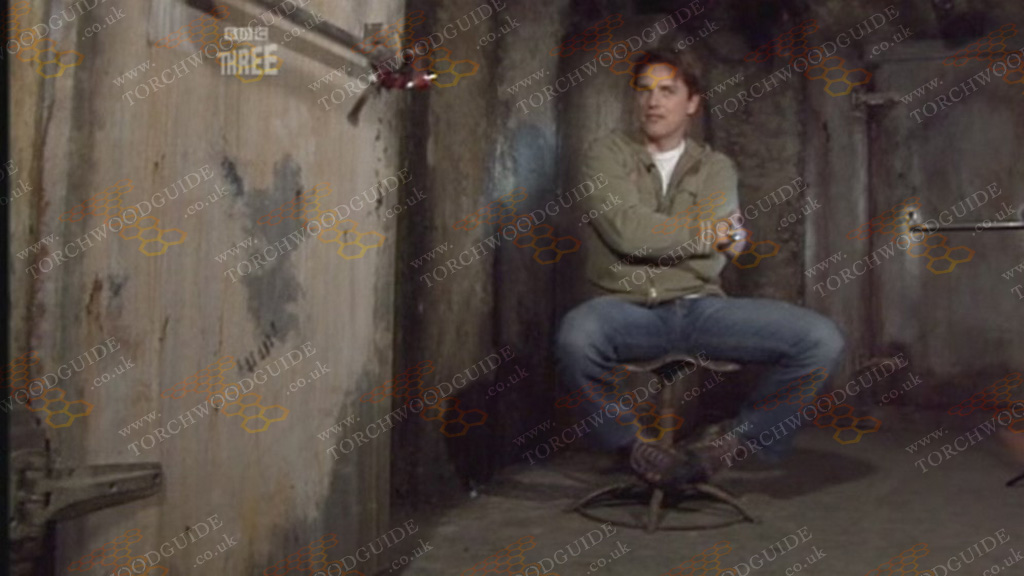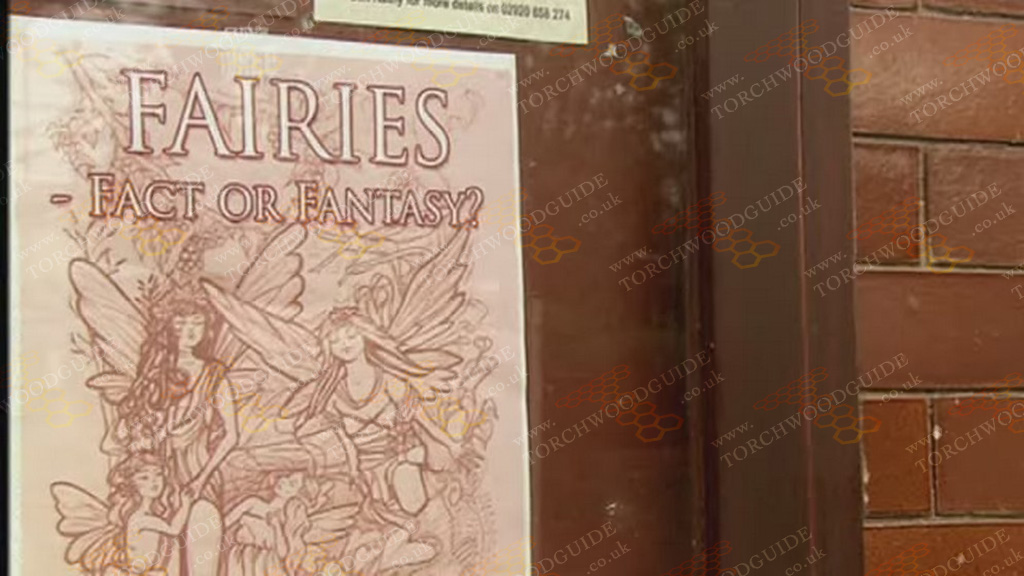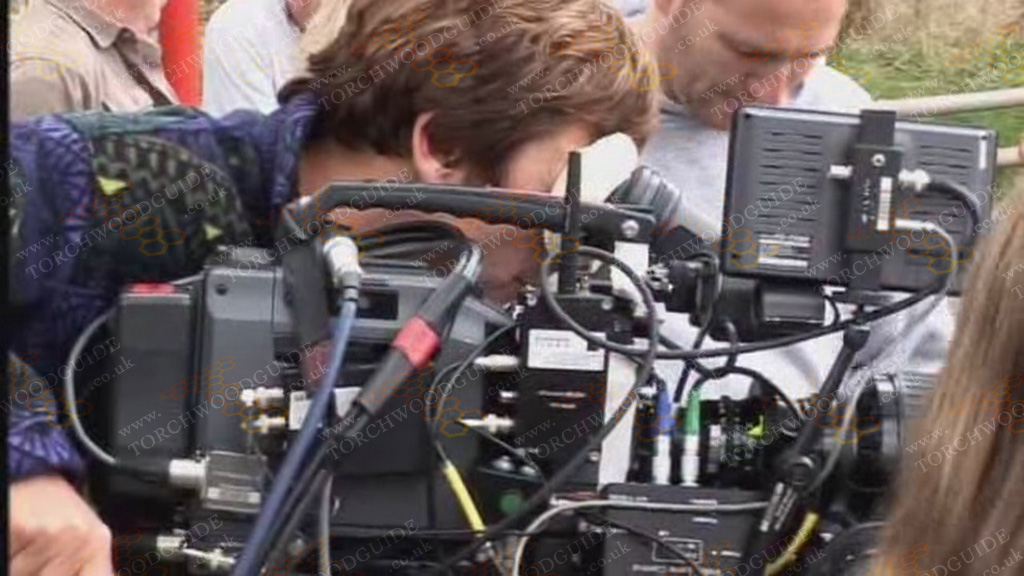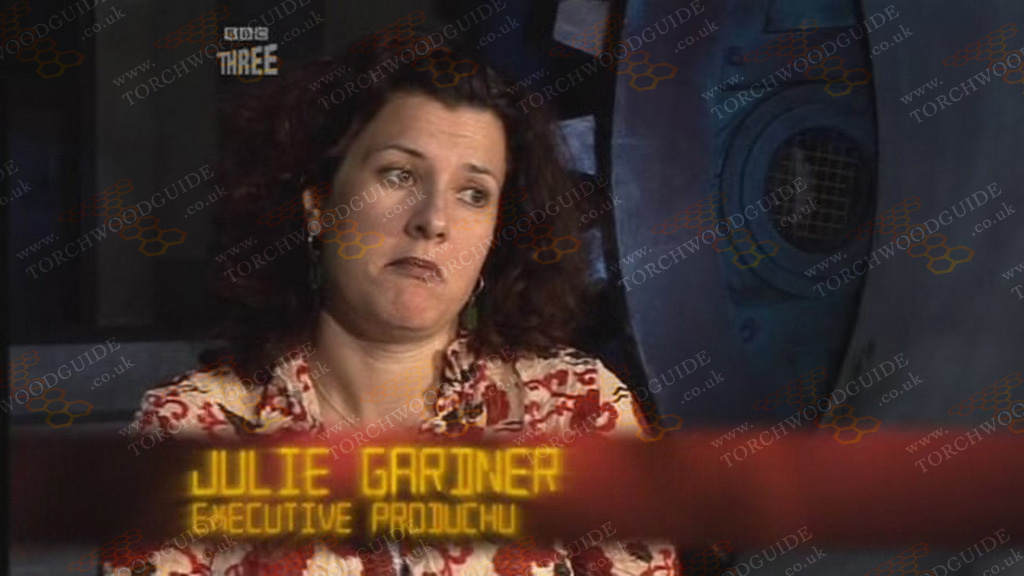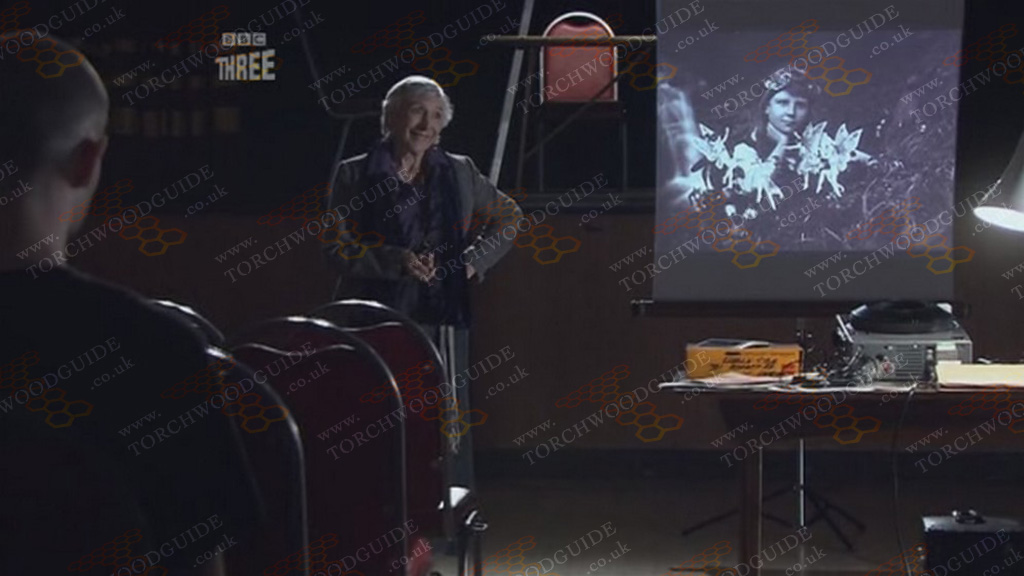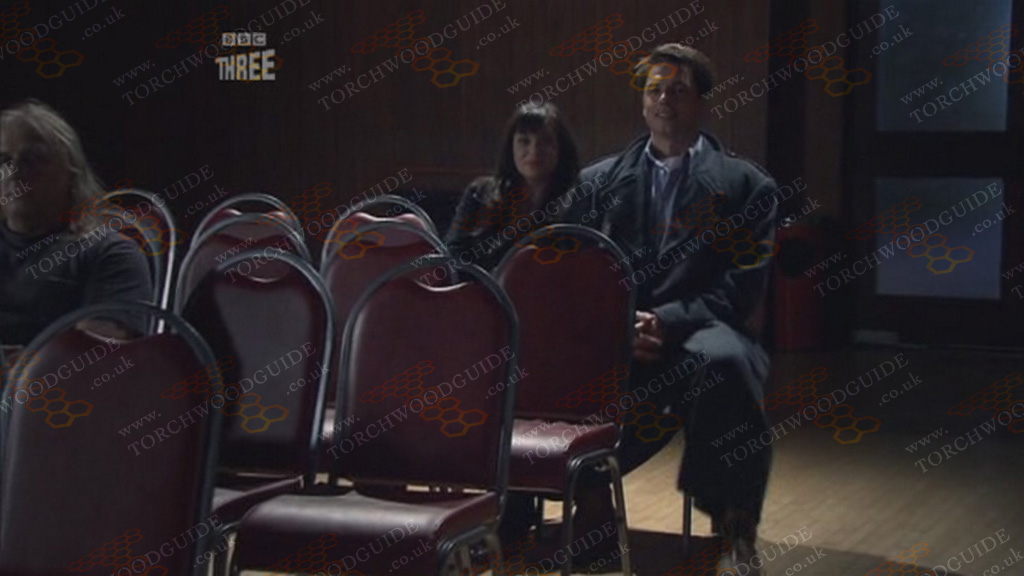Jasmine is a withdrawn but intelligent child whose new ‘friends’ exploit her suppressed anger, and while investigating this, Jack encounters elemental enemies from his past that are determined to harm those closest to him.
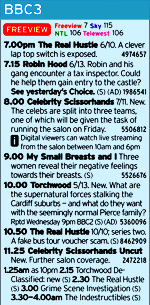
Length 46’44”
First Transmitted
10pm, 12th November 2006, BBC Three and BBC HD
9 pm, 15th November 2006, BBC Two
Guest Cast
Kai Owens (Rhys); Eve Pearce (Estelle); Lara Phillipart (Jasmine [Pearce]); Adrienne O’Sullivan (Lynn); William Travis (Roy); Roger Barclay ([Mark] Goodson); Heledd Baskerville (Kate); Ffion Wilkins (WPC); Nathan Sussex (Custody Sergeant); Paul Jones (Man in Street); Sophie Davies, Victoria Gourley (Bullies)
Writer Peter J. Hammond
Director Alice Troughton
Setting
Cardiff, across four days. (Estelle photographs the fairies “a couple of nights ago.”) Torchwood is set in 2007, Estelle believes that will make “Jack Sr” in his early 90s. Barrowman is currently age 39, so if we assume that Jack told Estelle that was his age when he last saw her, they would have parted company just over 50 years ago, in the early 40s. This all makes sense internally, but it’s also worth noting that a 40 year old “Jack Jr” would have been born in the mid 60s, when his “father” would have been in his late 50s/early 60s. Not bad going! Jack’s watch shows 10:30 when Jasmine finally joins the fairies.
Did You Spot?
3-D glasses are visible on the lampshade in Jack’s office; they are anaglyph, as are the ones the Doctor used in Doomsday (2006) however they are a different shape, and therefore not the exact glasses. The large print of a fairy hung on Estelle’s wall is entitled ‘Midsummer Eve’, c.1908 by Edward Robert Hughes. The railings that Goodson walks past on the way to Cardiff Market match those outside Queens Arcade from Rose (2005) as they were filmed in the same area. Sato returns to her origins as a pathologist as she examines her first dead body (Everything Changes, in which she just asks some questions, notwithstanding) since Aliens of London (2005).
Twisted Reality
Roundstone Wood doesn’t really exist. Plymouth Road, however, does – in Penarth. Estelle is giving a lecture on Fairies, with notable reference to the “Cottingly Fairies” – a series of 5 photographs taken in 1917 and 1920 by Frances Griffiths and Elsie Wright. The cousins would at times over the years claim the photos were both genuine, and at other times fakes. At least two motion pictures have been based around these photographs. The Mara is a creature in many mythologies, and also known in Doctor Who as the snake-like creature Tegan encountered in her mind on Deva Loka. The Mara Jack refers to is from German and Scandinavian folklore. They are female wraiths that sit on the chests of the sleeping and inflict nightmares. Under current UK law, upon arrest a detainee must be treated “humanely and with respect”. Although the WPC did need to be firm with him as he was being physically aggressive, Goodson was clearly disturbed and the reaction “you crazy bastard”, and slamming him into the hood of her car wouldn’t be proper practice.
Love is in the Air
Jack touches Ianto’s shoulder, and the reaction suggests more than friendship. Jack and Estelle dated in wartime London, approximately 1940. Goodson had a “fondness” for Jasmine. Lynn and Roy had been together for 5 years and were planning on starting a family.
If it’s Alien, it’s Ours
Captain Jack is seen using his wrist device yet again, this time as a scanner when they first enter the Roundstone Wood in the daytime.
Torchwood Shop: Now Open for Business
Although we’d already seen the side of the Torchwood van, we now see the roof also has a dirty great big logo. No doubt to help helicopters tracking them.
Cymru am Byth
At Jasmine’s school, two displays read ‘Bwyd iechyd’, loosely translated as ‘food health’.
To Live and Die in Cardiff
Goodson suffocates from the fairy rose petals. Estelle drowns in the fairy rainstorm. Fifteen of Jack’s squad die of suffocation. Roy also suffocates at the hands of the fairies.
Sounds Brilliant
At Jasmine’s school, we hear Lord of the Dance, the 1963 hymn by Sydney Carter. As Jasmine helps Lynn prepare food for the party, ‘Better Do Better’ by HARD-Fi plays; as they take the food out we hear Kaiser Chiefs’ ‘Born to be a Dancer’. The Kooks’ ‘Oooh La’ plays as Roy makes a toast.
Quotables
“Because fairies are shy, you see. But I know in my heart that they’re friendly, loving creatures. Thank you.” – Estelle
“Wrong; she always gets it wrong.” – Jack
“Something from the dawn of time, how could you possibly put a name to that.” – Jack
“Are we talking alien?” – Gwen
“Worse.” – Jack
“How come?” – Gwen
“Because they’re part of us. Part of our world, yet we know nothing about them. So we pretend to know what they look like. We see them as happy. We imagine they have tiny little wings and are bathed in moonlight.” – Jack
“But, they’re not?” – Gwen
“No. Think dangerous. Think something you can only half see, like a glimpse, like something out of the corner of your eye, with a touch of myth, with a touch of the spirit world, a touch of reality all jumbled together. Old moments and memories that are frozen in amongst it. Like debris spinning around a ring planet; tossing, turning whirling. And backwards and forwards through time. If that’s them we have to find them. Before all hell breaks loose.” – Jack
“The children and the spirit world – they go together.” –Jack
“It wasn’t you dad that was in love with her all those years ago, was it? It was you.” – Gwen
“We once made a vow that we’d be with each other till we died.” – Jack
“In the whole of my working life I have never had to bring the bad times home with me. I have never had to feel threatened in my own home. But not anymore, because this means these creatures can invade my life whenever they feel like it and I am scared Jack. What chance did Estelle have? What chance do any of us have?” – Gwen
“Suppose we make her stay with us? – Jack
“Then lots of people will die.” – Jasmine
“They tell you that?” – Gwen
“They promised.” – Jasmine
“Take her.” – Jack
“Jack, no!” – Gwen
“You asked me what chance we have against them; for the sake of the world, this is our only chance!” – Jack
Weren’t You In?
Eve Pearce had roles in The 10th Kingdom (2000), Great Expectations (1989) amongst a long list of guest roles dating back to the 1960s. Adrienne O’Sullivan played Ginny Edwards in Hearts of Gold (2003) and Linda in two episodes of Up the Garden Path (1993). William Travis played Dick Lampard in 11 episodes of Where the Heart Is (2002) and Al in No Angels (2004-05). Roger Barclay played Mitchell Oatis-Aronovitz in Broken News (2005), and Captain Carter in Pride and Prejudice (1995).
Unanswered Questions
Why isn’t Estelle worried about alerting and/or scaring off the fairies by using the flash on her camera? Did she not hear them “growling” as others were able to later on? Is Jack sleeping at the start or simply resting his eyes and having a flashback? Most likely the latter: we already know he doesn’t sleep, and also we see him closing his eyes moments before the ‘dream’ – REM sleep (the dream cycle) doesn’t start that quickly. Are the fairies simply warning Jack of what’s to come by causing his nightmare and leaving the rose petal on his desk? Does no one know that Jack lives below the Hub? (Ianto seems to think Jack shouldn’t be there in the middle of the night.) Are cars normally allowed to drive through parks? How does Goodson walk through Cardiff Market clearly choking and bleeding with barely a reaction from anyone, not even the policeman that’s queuing for food? How did the first few petals Goodson was choking on even get in his mouth? (Later, we see how the fairies choke their victims – the rose petals are there as a result, but that didn’t happen to him at first.) What happened to Goodson’s car? Jack contacted Estelle a “few years ago” – how long has he been in Caridff? Why do the fairies come for Estelle; she never hurt them? Did they do it to get at Jack? Does it have anything to do with his immortality? Although fairy myths have been around for centuries (which would match Jack’s description that they’d existed for millennia), the current depiction of them that the “good fairies” take on has only been in popular culture since the 1800s – what did they choose to look like before then? Gwen doesn’t have her facts straight: Although the Cottingley fairies were proven fake in 1978, when the original images were discovered in the 1915 piece ‘Princess Mary’s Gift Book’, one of the cousins maintained until her death that they were genuine. Why do the fairies kill Estelle? Why does Owen suddenly leave after they find Estelle’s body? To be courteous to Jack? If so, why doesn’t Gwen leave them alone also? What was Jack doing in 1909? (Was this a pre-‘Empty Child’ Jack, in his Time Agent Days, or was post-‘Parting of the Ways’ Jack dropped off c1900 and didn’t age since?) Why were the petals so far down Goodson’s throat when they were falling out of the mouths of the other victims we saw? If fairies are photographable, why didn’t they show up on the CCTV footage? Would Jack have considered staying with Estelle if it weren’t for the war? Why are all the other deaths so labored, and Jack’s squads’ so quick? Is Jack’s immortality why he wasn’t killed with his men in 1909? Only some of the men had killed the child, so why did the fairies kill all 15 of the men, and leave Jack alive? Do they have a vendetta against him because they know they can’t kill him? (Is this also why they wreck Gwen’s apartment – attack those close to Jack?) Why didn’t the fairies attack Jack? Why isn’t Ryhs helping clean up when Jack comes by the apartment? How long has Jasmine been a chosen one? Is it a birthright? Was she never a normally behaved child? (This is inconsistent with Roy’s observation of it being some time since Jasmine read a book, watched TV, laughed, etc.) Why were we led to believe that the fairies would come after Lynn? (They did leave her alone later during the final attack.) How did the teacher not see who pushed Jasmine? Who has a big party at mid-day on a weekday? (Jasmine is at school during the party preparations.) How does Lynn know (and, in fact, Owen and Toshiko) that Jack let Jasmine be taken by the fairies? Are the fairies still haunting Gwen at the end of the episode? What turns the monitor back on? Or do they just want to show her that Jasmine did live forever?
Fuck Ups
Estelle uses a camera with flash without the stability of a tripod at night and still ends up with a semi-clear photo of the fairies without any blur lines. Owen says Roundstone Forest was all forest in primeval times. Most forests were all forest in primeval times! Goodson’s cell could apparently be seen by four other prisoners who claimed not to see his death – the layout of the cell block would make this impossible. Who carried the toolbox into Goodwin’s cell? Roy shows an awful lot of insight into Jasmine’s behaviour considering his apparent dislike for her. Jasmine is also not that old and Roy has been with Lynn for five years; he doesn’t dislike children as he was hoping to start a family with Lynn before his demise, but in five years has taken no interest in Jasmine? Where did Roy get fencing that *exactly* matched what was already up? Why does the fence not splinter when the fairy bursts through it? Also, when it’s seen physically, the hole is just by a small break, but in the CG version there is no break, and there seems to be more space by it, rather than tucked behind a shed. Due to the editing, Jack appears to spin Jasmine round twice as he grabs her to protect her. Wouldn’t the meat on the grill cook better if Roy thawed it first? The hole made by the fairy breaking through the garden fence isn’t the same in the real shot as it is in the CGI one. As Torchwood leave Jasmine’s house, a boom mike can be seen reflected in the gloss paint of the family VW.
Torchwood: Declassifed Episode 5 (Length: 10’04”)
Broadcast BBC Three, Monday 13th November, 2:40am.
A look behind episode five, introduced by Russell T Davies, Julie Gardner, Eve Myles, Peter J Hammond and John Barrowman. After the credits, Davies compares the leads to Mulder and Scully while Burn Gorman, Myles, Davies, Barrowman and Hammond elaborate on the darkness of the plot. Davies and Alice Troughton praise actress Lara Philippart, who explains her character.
Gorman, Naoko Mori, Philippart and Paul Bennet talk about filming in a high school, while Myles and Hammond return to the subject of scary fairies. Davies, Troughton, Barrowman and Gardner on Jack’s dark past and Hammond specifically on the tragedy of his love. Gardner talks about the reality of certain plot elements, and Will Travis talks about his character. Nick Rae talks us through Roy’s death scene and Myles, Barrowman and Travis explain the difficulty of acting with CG.
Gardner finishes up by covering the loneliness of command and Barrowman and Hammond the creepiness of the final moments.
Davies, Barrowman and Myles preview the following episode.
Site Review by Rob Tizzard
We’re in full swing now and each week feels like a proper adventure rather than another character introduction. And this week, RTD has called upon the force of spooky Sapphire & Steel creator, P J Hammond, who clearly relishes the chance to let go a little. The script still feels a tad reigned in though, which is a shame.
More is learned of Jack finally, and he is clearly haunted in this one, which only highlights one of the character’s faults for me. For the kind of trauma Jack has experienced, he should be much more sombre, rather than the laughing fool he sometimes is. Whatever he’s hiding should be with him always, but then he’s an alien, so in reflection, his odd characteristics should be acceptable.
The rest of the gang are little more than back-up in this episode, but there are a couple of points with them. Ianto seems totally over his recent experience, which suggests some time has passed, surely. And it seemed odd that Gwen suddenly suspected the possibility of time travel without having seen any proof of such thing so far, well, on screen at least. And a special mention must go to the cowardly cat, Moses, who should be adopted by Torchwood.
I suspected Who fans went wild at the mention of ‘The Mara’, a fascinating enemy from Doctor Who in the eighties. Is this here for a reason, as RTD has mentioned that this particular being is ripe for re-invention. P J weaves a very different, chilling and welcome tale and I only hope the rest of the series keeps the momentum going. And it’s about time Toshiko took centre stage…
Reader Reviews
Small Worlds proved to be a very welcome return to television fantasy writing for Peter J. Hammond, creator and writer of the legendary Sapphire and Steel. I’ve always held Hammond in the greatest possible regard following his work on that series and the news that he was to be on the writing team for Torchwood came as both a surprise and a tonic to me. Surely his involvement was a guarantee that Torchwood would be a quality product.
On a par with Helen Raynor’s Ghost Machine and head and shoulders above the other episodes that preceded it, Small Worlds is a compelling, fascinating tale of malevolent fairies who date back to the dawn of time. The script more than lives up to expectations afforded it given its high profile writer, and it could be said that P.J. Hammond serves a lesson or two to the likes of Russell T. Davies and Chris Chibnall in terms of how to write mature, post-watershed TV drama. There are trademark Sapphire and Steelisms on show (the protagonists being a familiar childhood staple portrayed against expectations; the sacrifice of an innocent to nullify the threat), but if anyone has a right to use them, then P.J. Hammond is that man! They fit in perfectly with the Torchwood format, and one cannot help but see parallels between Jack and Steel when the former realises he must allow the fairies to take their “chosen one”. It is an unpopular, almost inhuman thing to do, and yet Jack realises there is no alternative, in much the same way as Steel coldly sacrifices the likeable Tully for the greater good in the astounding ‘railway station’ Sapphire and Steel adventure.
The other intriguing element of Small Worlds is the start of the gradual exploration of Jack’s backstory, which is handled very effectively, opening the series out to new possibilities. Jack’s friendship with the elderly Estelle stretches back over nearly 70 years and he’s barely aged a day, giving a poignant insight of Jack’s ‘outsider’ nature. The scenes John Barrowman plays with Eve Pearce (Estelle) are perfectly judged and touching, and for me, represent Barrowman’s highpoints of the series so far. I didn’t think I would, as I wasn’t over struck with Captain Jack in Doctor Who, but I find myself increasingly becoming fascinated with the character as presented in Torchwood. OK, so I could probably do without Captain Jack becoming the new Captain Scarlet – the idea that he is indestructable is a bit “Boys’ Own Adventure”, but otherwise, the backstory is coming along very nicely, thank you.
The fairies are well realised, and the deaths they cause disturbingly graphic. Top marks for the CGI and to the actors and direction, which is exemplary throughout.
Overall, a thought-provoking and exciting episode with a multi-layered narrative that just screams confidence and class at every opportunity. Great script, great production. If Torchwood was of this standard each week, then we’d all love it unconditionally. Instead, Small Worlds and Ghost Machine before it merely serve as isolated examples of what is possible when the series strives to rise above the misplaced maxim that to be adult you need sex, snogging and swearing. A superb example of 21st Century TV drama.
Alan Hayes

